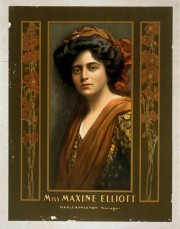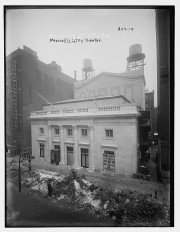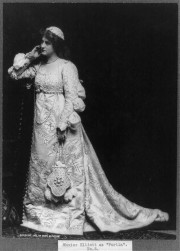Motion pictures . . .
The Eternal Magdalene (1919)
The Fighting Odds (1917)
When the West Was Young (1913)
A Doll for the Baby (1913)
Samaritan (1913)
(1873-1940) was born as Jessie C. Dermott in Rockland on February 5, 1873.
The daughter of sea Captain Thomas Dermott and his wife Adelaide, she had a younger sister May Gertrude, born in 1874, who also became a celebrated actress using the name Gertrude Elliott.
They were both born in “The Old Dermot Place,” as Down East magazine entitled an article about the homestead. It was originally at the current site of the Rockland City Hall. It was later moves to the current site of the passenger train depot at 4 Union Street. A plaque recognizing the Elliott sisters birthplace hangs inside Trackside Station.
She is said to have been one of the most photographed and beautiful actors at the beginning of the twentieth century. She was the star of the stage and motion pictures. In 1908 she built the Maxine Elliott Theatre on 39th Street, in the Times Square area off Broadway in New York – the first woman to finance and build a theatre there. (Photo of the theater is at left. No date is available and the title was from unverified data provided by the Bain News Service on the negatives or caption cards, according to the Library of Congress.)
Much of the sisters childhood was spent aboard a sailing ship of which their father was captain, plying the North American sea lanes. Maxine was educated at the Notre Dame Academy at Roxbury, Massachusetts, before striking out to pursue a career as an actress in New York as a tender sixteen year old. Her first professional stage appearance was in the role of ‘Felicia Umfraville’ in “The Middleman” at Palmers Theatre in New York on 10th November, 1890. That was with the company of the great English actor/producer Edward S. Willard, in his first US production. She remained with Willard for the next three years, touring the USA and Canada in various productions, most notably “The Professor’s Love Story”, one of Willard’s greatest successes. She began to use the stage name ‘Maxine Elliott’ at the suggestion of the great actor and dramatist Dion Boucicault. Her sister Gertrude would adopt the same surname for her own stage career. [Maxine Elliott (1873-1940)] (Photo right is Elliott posing a Portia in about 1901.)
As a young actress, her many boyfriends included baseball’s Hall of Famer John Montgomery Ward and heavyweight champion and actor “Gentleman” Jim Corbett.
She quit her acting career during World War I to finance and staff a floating hospital to nurse wounded soldiers in France.
Maxine Elliott died in France on March 5, 1940 from a heart ailment.
Additional resources
Forbes-Robertson, Diana. My Aunt Maxine: The Story of Maxine Elliott. New York, Viking Press. 1964.
Library of Congress. Prints & Photographs Online Catalog. http://www.loc.gov/rr/print/catalog.html. (accessed 11/1/2006)
Maxine Elliott (1873-1940). From the Internet site “Stage Beauty” at http://www.dgillan.screaming.net/stage/th-frames.html?http&&&www.dgillan.screaming.net/stage/elliott/elliott-m2.html “This website is dedicated to the female stars from the golden age of English Theatre.” (accessed 11/1/2006)
Maxine Elliott Collection. Special Collections, Fogler Library, University of Maine. Orono. “Her collection, spanning 1846-1940, includes correspondence, diaries, photos and playbills from her 30-year acting career. Also included is the manuscript of the biography written by her niece, Diana Forbes-Robertson, My Aunt Maxine.”
“Experiencing History: Fogler Library’s Special Collections provides an enriching exploration of the past.” UMaine Today. September/October 2004. http://umainetoday.umaine.edu/issues/v4i4/exphistory.html. (accessed 11/1/2006)
“The Old Dermot Place.” Down East. Camden, Me. April, 1991. p. 46.
Woollcott, Alexander. “The Truth About Jessica Dermot.” Hearst’s International Cosmopolitan. October, 1933. pp. 62-63, 173-175.





